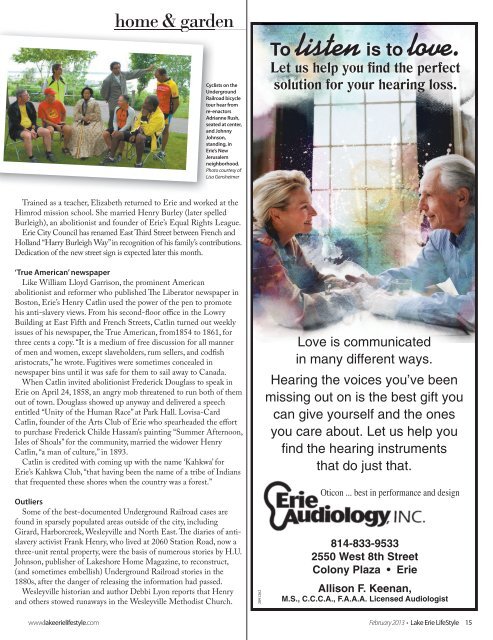Download this publication as PDF - WQLN
Download this publication as PDF - WQLN
Download this publication as PDF - WQLN
You also want an ePaper? Increase the reach of your titles
YUMPU automatically turns print PDFs into web optimized ePapers that Google loves.
home & garden<br />
Cyclists on the<br />
Underground<br />
Railroad bicycle<br />
tour hear from<br />
re-enactors<br />
Adrianne Rush,<br />
seated at center,<br />
and Johnny<br />
Johnson,<br />
standing, in<br />
Erie’s New<br />
Jerusalem<br />
neighborhood.<br />
Photo courtesy of<br />
Lisa Gensheimer<br />
Trained <strong>as</strong> a teacher, Elizabeth returned to Erie and worked at the<br />
Himrod mission school. She married Henry Burley (later spelled<br />
Burleigh), an abolitionist and founder of Erie’s Equal Rights League.<br />
Erie City Council h<strong>as</strong> renamed E<strong>as</strong>t Third Street between French and<br />
Holland “Harry Burleigh Way”in recognition of his family’s contributions.<br />
Dedication of the new street sign is expected later <strong>this</strong> month.<br />
‘True American’ newspaper<br />
Like William Lloyd Garrison, the prominent American<br />
abolitionist and reformer who published The Liberator newspaper in<br />
Boston, Erie’s Henry Catlin used the power of the pen to promote<br />
his anti-slavery views. From his second-floor office in the Lowry<br />
Building at E<strong>as</strong>t Fifth and French Streets, Catlin turned out weekly<br />
issues of his newspaper, the True American, from1854 to 1861, for<br />
three cents a copy. “It is a medium of free discussion for all manner<br />
of men and women, except slaveholders, rum sellers, and codfish<br />
aristocrats,” he wrote. Fugitives were sometimes concealed in<br />
newspaper bins until it w<strong>as</strong> safe for them to sail away to Canada.<br />
When Catlin invited abolitionist Frederick Dougl<strong>as</strong>s to speak in<br />
Erie on April 24, 1858, an angry mob threatened to run both of them<br />
out of town. Dougl<strong>as</strong>s showed up anyway and delivered a speech<br />
entitled “Unity of the Human Race” at Park Hall. Lovisa-Card<br />
Catlin, founder of the Arts Club of Erie who spearheaded the effort<br />
to purch<strong>as</strong>e Frederick Childe H<strong>as</strong>sam’s painting “Summer Afternoon,<br />
Isles of Shoals” for the community, married the widower Henry<br />
Catlin, “a man of culture,” in 1893.<br />
Catlin is credited with coming up with the name ‘Kahkwa’ for<br />
Erie’s Kahkwa Club, “that having been the name of a tribe of Indians<br />
that frequented these shores when the country w<strong>as</strong> a forest.”<br />
Outliers<br />
Some of the best-documented Underground Railroad c<strong>as</strong>es are<br />
found in sparsely populated are<strong>as</strong> outside of the city, including<br />
Girard, Harborcreek, Wesleyville and North E<strong>as</strong>t. The diaries of antislavery<br />
activist Frank Henry, who lived at 2060 Station Road, now a<br />
three-unit rental property, were the b<strong>as</strong>is of numerous stories by H.U.<br />
Johnson, publisher of Lakeshore Home Magazine, to reconstruct,<br />
(and sometimes embellish) Underground Railroad stories in the<br />
1880s, after the danger of rele<strong>as</strong>ing the information had p<strong>as</strong>sed.<br />
Wesleyville historian and author Debbi Lyon reports that Henry<br />
and others stowed runaways in the Wesleyville Methodist Church.<br />
<br />
<br />
<br />
<br />
<br />
<br />
<br />
<br />
<br />
<br />
<br />
<br />
<br />
<br />
<br />
<br />
<br />
<br />
www.lakeerielifestyle.com February2013 Lake Erie LifeStyle 15


